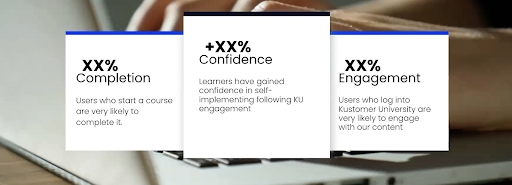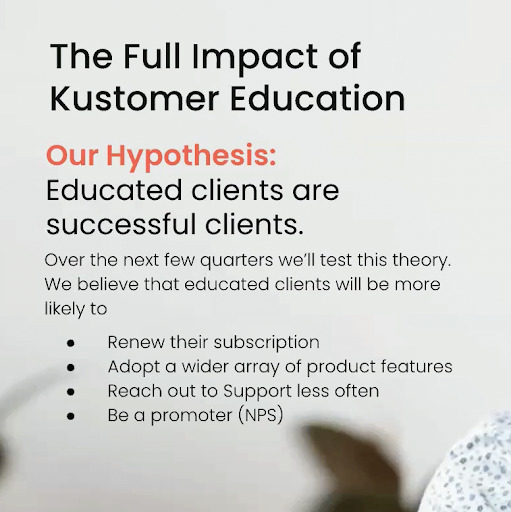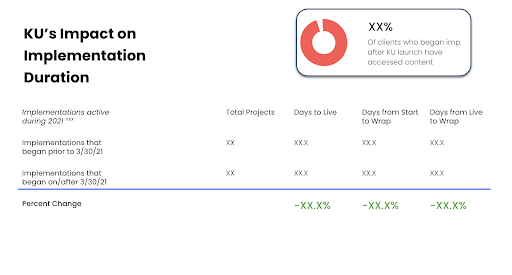How Kustomer Built a Customer Education Program From the Ground Up
WorkRamp Contributor
Learning Tips Straight to Your Inbox
One of the most underestimated competitive advantages a business can have is customer education. The benefits of a customer education program are endless, from quickly getting your customers up and running on your product to building long-lasting customer relationships and brand advocates.
And while educating your customers is essential, how you educate them is even more essential–and will set you apart from your competitors.
Learning is not a one-way-fits-all, and neither is building out your customer education program. We brought in an expert to share how you can build a robust customer education program beneficial to your customers and one of your organization’s power tools for business impact and growth.
In our recent webinar, WorkRamp’s VP of Marketing, Jack Foster, chatted with Kristi Thurston, Learning Solutions Manager at Kustomer, to discuss what Kustomer did to build out their customer education program, what metrics to monitor, and more.
“Clients only onboard for a certain amount of time, and then they’re let loose into the world. I wanted to make sure anything I was doing wasn’t negatively impacting anyone downstream but helping alleviate customer struggles.”
Read on to discover:
- How to align leadership and internal stakeholders around your goals
- What the fundamental strategies are to create engaging content for customers
- The essential metrics to track your program
- How to map out your long-term plan
In this post:
When do you know it’s time to invest in customer education?
You know it’s time to invest in a customer education program when what you’re doing already is not scalable. “At Kustomer, we reached a point in startup life where we would continue to grow. The implementation managers were leading some training for clients and other teams. Essentially, what we were doing was not scalable, and my boss (the Director of Professional Services) knew what we were doing wasn’t going to be scalable,” says Kristi.
So, Kustomer made the case to key stakeholders about the importance of customer education and why they should invest in launching such a program. Kustomer looked at improving the client onboarding experience alongside client implementation.
What is the ultimate goal (Northstar) of having a customer education program?
With a product that has many different features, one of Kustomer’s goals was to launch a customer education program to educate users about the platform and on all the features. But where do you start first? “After discussing this with my manager, a big goal of hers was to reduce the amount of time it took to implement a client. That was the first metric business impact I knew I would be driving towards. That guided a lot of the research that I did that followed,” says Kristi.
Some key goals Kustomer looked at:
- Reduce the amount of time it takes to implement a client
- Support self-implementing clients
Who should be involved in building a customer education program?
It’s essential to really get a good understanding of what is currently going on during your customer onboarding process and what gaps there are to fill. One of the first things before even bringing others into the planning is to take a step back and observe what’s being done.
“When I first started, I went to my boss, and I said, ‘I’m not doing anything for the next month, other than analysis.’ I did an assessment, and I spoke to the leader of professional services). I spoke to the head of customer success customer support and talked to product to make sure that I understood all of the moving pieces that were going on. I wanted to understand what all their metrics and OKRs were,” shares Kristi.
Kristi needed to understand the customer’s pain points and what the team needed to prepare the client for once done with onboarding.
Some questions Kristi asked the stakeholders involved to help paint a clear picture of what was currently going on:
- What have they seen work well?
- What has not worked well?
- What are their current goals?
- What would they like to see in a customer onboarding program?
“I wanted to be aware of what was available to me, data-wise, what other leaders thought would be big needs in the future. At those very early stages, it was just understanding our customers better understanding what the leaders want and need. And most importantly, what data was currently available that I could even start looking at knowing that in the future when I’m asked, ‘How well is Kustomer University working?’ I would know what I could draw upon later and use that to influence what we were doing,” explains Kristi.
Kustomer’s Lessons Learned
The first step in creating a customer education program is to find a subject matter expert (SME). “Since we didn’t have a formal customer education program, and not really a lot of formal training programs in general, I needed an SME. I needed subject matter experts to tell me what I didn’t know,” shares Kristi.
When trying to find out if the person is the best fit as an SME, Kristi suggests:
- Set expectations right away
- Set response time expectations
- Share the deadlines and timeframes
- Share the goals you are trying to achieve
Kristi also suggests having more than one subject matter expert in each area if you have multiple areas of learning. Kustomer had an SME from the following:
- Implementation
- Customer success
- Customer support
“Everyone experiences different things. And we wanted to make sure that what we were doing wasn’t within blinders, just because I was on professional services.”
Kristi points out that while building out your program, it’s essential to show appreciation to all those working on the program with you, especially to the SMEs.
“We publicly acknowledge and thank our SME as much as we can to make sure that everyone’s also aware of their contributions. It’s turned into a really awesome system where we create a course that the SME goes back and just brags about because they worked on it too. And now everyone knows that it’s there, and the teams are really adopting it.”
Create the environment where they help you gather all the information you need to build a solid customer ed program, and in return, you thank them, so they are excited to share what they worked on with the world. Essentially, they will be one of your biggest advocates.
How to create winning content for your customers
One of the first things you need to understand is your learners (audience). Kustomer chose to focus on customers who may have never worked with a CRM before or smaller customers with a larger learning curve. This way, the Kustomer team could really determine what they needed to focus on for their educational content. Kustomer wanted to use clients who would ask many questions because they could turn those questions into content for their education program.
How to make sure the content you create is engaging
The difference between a customer education program vs. live training, you have to let them know that the program isn’t going to suck up much of their time. Unlike live training, where you can give them an hour full of snippets, you have to convince them to take it in the customer education program. So creating a stress-free program is essential. And, because people are busy with their day-to-day responsibilities, keeping content short is a must: Micro-learning.
“I think there have been studies of how much time the typical person has for learning and development in a week. And it’s about 10 minutes. So, it was important for us to keep our content to 15 to 20-minute bites.”
If the content requires more time to learn, simply separate it into a new section.
Kustomer recommends:
- Keep lessons 3 – 5 minutes long
- If lessons run longer than 10 minutes, break them into a new section
- Keep your overall course 12-20 minutes long. If longer, again, break it up into a new area.
Once Kustomer found their sweet spot for timing, they then looked at what the content would look like. Kustomer didn’t want to have formal slides for their customer education program. They wanted it to be fun, engaging, and social. So, it’s essential to think through the following:
- Voice, tone, and style
- Type of content used
Kustomer chose a casual voice and tone and ensured the videos used had high energy and excitement to engage the learners. Once they were able to determine how they wanted their program to be, they could create content that fits into their box.
“Focus first on what the learning experiences will be like, and then fit the content into that.” Kristi adds, “And, keep the content active.”
Using video is excellent, but it’s passive, and people watching can tune out. So, to avoid this situation, Kustomer creates an interactive environment where they use a mix of Buttons and Flashcards to keep the audience engaged. They use GIFs or animations to switch up the content, and they pepper in questions throughout the course, not at the end.
“The moment that something is passive, distractions can come in. So, if you’re keeping them active and things are visually changing, you’re keeping something interesting. Create visual interest and an activity to do.”
How do you measure the success of your customer education program?
Think about your metrics in three phases.
- The first six months
- The second six months
- Ongoing after the year mark
Phase one: Month 1- 6
Since you haven’t launched anything yet, you don’t have any metrics to measure. “You don’t want to go to leadership with all of the amazing business impact metrics that you hope to impact which you found during your assessment. I couldn’t go to my boss and say, ‘yep, I am reducing the time to implement this when I haven’t even implemented my program yet.”
For the first six months, your goals should be:
- Understand the type of content you need
- How much content do you need
- How much time do you need to launch
- Launch the program
Phase two: Month 6 -12
You’ve launched your program. Instead of looking at business impact–you’re not quite there yet–look at the adoption, registration, implementation, completion, drop-offs, etc. This gives you a look at the program’s content and how people are engaging with it. You can look at whether you need to adjust for better adoption rates or completion rates. Think of phase two as the data collection period.
The second six months, your goals can look something like this:
- Adoption and implementation rate
- NPS scores
- Certifications completed
- Completion and drop off rates
- Engagement rate (Ex: How many questions were answered?)
Phase three: Month 12 and ongoing
This is when you can start delivering what your leadership team wants: business impact.
By this point, you have been researching and collecting data. You should be meeting with key stakeholders regularly to check on their goals (has anything changed?), whether their team is changing, their conversations with customers, etc.
You might not have all the answers to business impact right at month 12, but you have a good picture of how things are performing because you have been tracking insights since the launch.
“Break down your metrics. Don’t just say a number overall. Instead, say something like the number of clients who took your training versus those who didn’t. Or, clients that are your target audience versus not your target audience.”
As you continue to track data–never stop collecting information–someone will ask you for a metric or insight, so having continuous tracking will help you present information when you are least prepared for it.

“This is really stuff that I presented in those first six to 12 months, and I’m still reporting on it. Doesn’t get less important. You can add onto it, but these are still significant numbers, and these are really important for me as the leader of my team.”
Then as you get farther along into your program, you can present the full impact with a hypothesis.

Be prepared to explain why you can or can not track certain things. Let the leadership team know the patterns you see and impact in one area versus another. As you have more data, you can report on other areas. But it is significant to communicate this to the leadership, so they are in the know of performance.

Finally, always ask for customer feedback on your program. There is always room for improvement, and if you want to keep improving business impact, you’ll want to make sure the content you deliver to clients is top-notch.
For more tips on building your customer education program, check out the entire webinar with Kustomer.
Ready to build your customer education program? Book a demo with WorkRamp.
Complete the form for a custom demo.
Recent Posts
- How to Drive Revenue Growth with Sales Enablement October 21, 2024
- 8 Best Salesforce Learning Management Systems (LMS) October 8, 2024
- 5 Steps to Create a Winning Sales Communication Strategy September 30, 2024
- WorkRamp’s Nine-Year Anniversary in Photos September 24, 2024
- WorkRamp Cover Story: Enabling Organizational Change at Sprout Social September 23, 2024
WorkRamp Contributor
You might also like
Lish Gates on Strategies for Scaling Enablement and Being Customer-Centric
Learn how to scale enablement, run a successful SKO, and build a global function from one of the best enablement leaders in the industry.
Read More
Back to the Basics—Bitly's Lessons on Customer Education
Tony Roma shares his strategy behind Bitly’s customer education program, which empowers users to create over 31 million custom links per day.
Read More
Exploring Consolidated Learning Strategies with Ted Blosser
In this episode of CELabs, WorkRamp CEO shares trends and opportunities in Customer Education – and his 10 year vision for the corporate learning industry
Read More
Decrease Ramp Time and Increase Revenue
Get in touch to learn how WorkRamp can help you achieve your enablement goals.
Request a Demo



